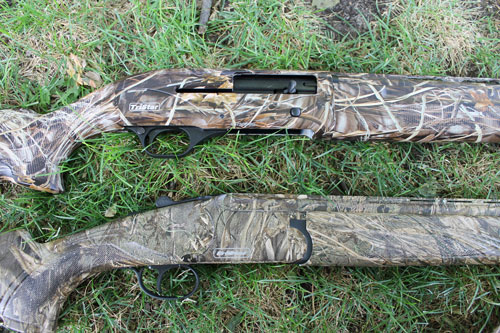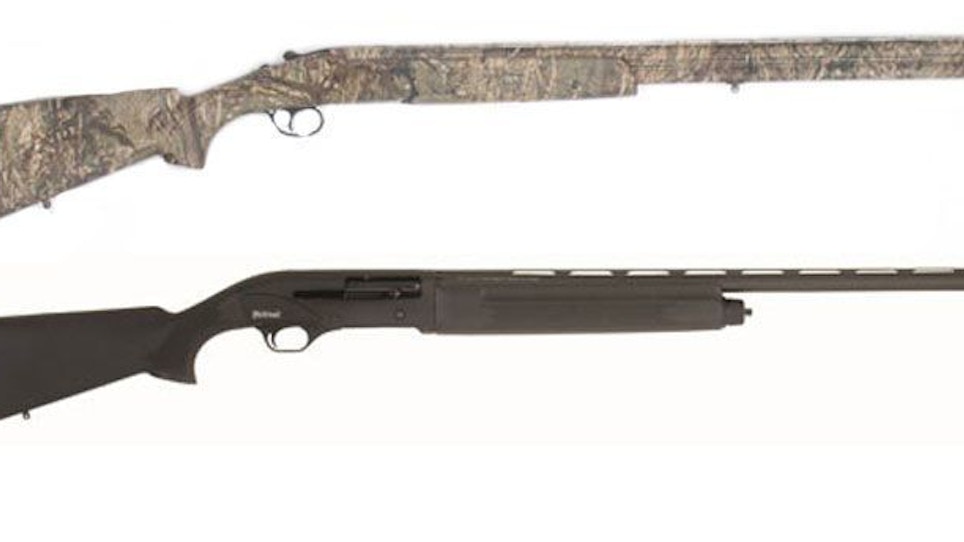 It would appear we’ve entered the age of the Turkish Import. These days, it seems everyone is importing scatterguns from Turkey, which has quickly become an epicenter of gun-making activity.
It would appear we’ve entered the age of the Turkish Import. These days, it seems everyone is importing scatterguns from Turkey, which has quickly become an epicenter of gun-making activity.
While British and Italian imports command the bulk of press and respect, the reality is they don’t make their way into American gun safes cheaply. Waterfowlers, in particular, have a need for rugged and effective shotguns they won’t cry over when they drop them in the bottom of the duck boat or ding them against the side of the blind. Enter the Turkish imports, which provide an affordable alternative to the expensive continentals.
TriStar Sporting Arms of North Kansas City, Mo., is one of the more reputable importers. Most of TriStar’s guns are designed for hunters, although there are some sporting and tactical models, as well as a new line of pistols. Last fall, I had the opportunity to try out a couple TriStar shotguns of interest to waterfowlers.
The first was the Hunter Mag, a synthetic-stocked 12-gauge over/under with 3 ½-inch chambers. The basic model comes in black synthetic with 28-inch barrels, the turkey model in Mossy Oak Break-Up camo with 26-inch barrels, and the waterfowl model in Mossy Oak Duck Blind with 28-inch barrels, which I tested.
I’m a big fan of over/unders for waterfowling. For the past 15 years, I’ve used an Italian-made over/under with 3 ½-inch chambers imported by American Arms, the predecessor of today’s TriStar. It has a wood stock, but what I would’ve given for a synthetic-stocked, camo over/under back in 1998. 
My test gun’s full-coverage Duck Blind camo finish is beautifully applied and flawless. By full-coverage, I mean even the swivel studs are camouflaged. The only parts not camo-dipped are the fore-end iron, trigger and trigger guard, top lever, and safety, all of which have a non-reflective, matte-black finish.
The unexposed portion of the mono-block is jeweled. Spent shells are removed via extractors, not ejectors, which not only cuts down on the gun’s overall cost, but is also one less part to wear out. An easily-seen, green, fiber-optic front sight sits atop the 28-inch barrels, which is, by the way, my preferred barrel length for a hunting double. The pancake-flat top rib is ventilated, as is the rib between the barrels.
The rubber recoil pad is rather plain-looking, but extra-soft, which is greatly appreciated when magnum and super-magnum loads are involved. The checkering on the synthetic stock and forearm is crisp and complimented by grooving, all of which combines to provide a sure grasp. There’s even checkering on the grip cap. Why, I don’t know, but it’s a nice detail.
One of the benefits of a double is the availability of two different choke options. The Hunter Mag comes with five flush-mount, screw-in choke tubes — skeet, improved cylinder, modified, improved modified, and full. The gun is threaded for Beretta Mobile-style chokes, but some of my aftermarket Mobile chokes wouldn’t fit in the gun, as the muzzle threading is a little rough. Of the aftermarket chokes I tried, Carlson’s fit the best, so I got Carlson’s waterfowl three-pack for the gun, consisting of close-, mid-, and long-range constrictions, to cover all waterfowling situations. The barrel selector is conveniently integrated into the safety, allowing quick switches from one constriction to the other as circumstances dictate.
I shot a few doves with this gun last fall, and was so impressed with its overall quality that I wrote TriStar a check for it at the end of the trial period.
 The second gun tested was TriStar’s TSA semi-auto, also with a 3 ½-inch 12-gauge chamber. While black synthetic, turkey camo, and 24-inch, 26-inch, and 28-inch barrel lengths are available, my test gun featured Max-4 waterfowl camo and a 26-inch barrel.
The second gun tested was TriStar’s TSA semi-auto, also with a 3 ½-inch 12-gauge chamber. While black synthetic, turkey camo, and 24-inch, 26-inch, and 28-inch barrel lengths are available, my test gun featured Max-4 waterfowl camo and a 26-inch barrel.
The gas-operated TSA uses a dual piston system to achieve load versatility. The Light Load piston is basically for 2 ¾-inch shells, while the Heavy Load piston is for magnum 3-inch and 3 ½-inch loads. While dealing with two pistons might sound cumbersome, TriStar came up with a nifty solution that makes the process painless. The spare piston is stored on the magazine tube underneath the magazine cap when not in use, so it’s always there when you need it.
As for load versatility, target loads tested were 1 1/8-ounce Estate at 1,200 feet per second, 1-ounce Cheddite at 1,250 fps, 1-ounce Winchester Xpert steel 7s at 1,325 fps, and 1 1/8-ounce Winchester Super Target at only 1,145 fps. Everything cycled and ejected just fine except for the low-velocity Super Target rounds, which isn’t unusual in an autoloader anytime velocity drops too far below 1,200 fps.
On doves, Winchester 1-ounce Game Loads with aluminum heads gave the TSA problems, so I quit using them after they didn’t cycle a couple times. To be fair, this same load gave a Benelli Vinci fits, too, so it might have been a problem with that specific box or lot of ammo. I then switched to Remington Gun Club 1 1/8-ounce loads and had no further problems except for one failure to cycle towards the end of the evening, but by then the gun was getting pretty dirty.
I had to return the TSA before duck season got underway, but before sending it back I installed the Heavy Load piston and ran some 3-inch and 3 ½-inch rounds through it, which worked fine. At one point, I loaded a 3 ½-inch 1 ½-ounce Kent Silver Steel round, followed by 3-inch 1 ¼-ounce Hevi-Shot Speed Ball and 2 ¾-inch 1-ounce Xpert shells. It handled the first two magnums just fine, but jammed when it got to the 1-ounce Xpert load. Loads lighter than 1 ¼ ounce probably shouldn’t be used with the Heavy Load piston.
For all my testing, I used the factory modified choke, as will most waterfowlers. The TSA comes with three flush-mount choke tubes — IC, modified and full. I happily discovered the TSA is compatible with Beretta’s excellent Optima-Plus choke system — a pleasant and unexpected surprise for a Turkish gun.
Other features include a thick, soft, ventilated recoil pad, sling swivel studs, and four shims for adjusting drop and cast. The gun had a rich, dark, Max-4 finish, and a green, fiber-optic, front sight sits atop the mostly flat, vent rib. The safety is conveniently located behind the trigger, and the trigger group features easy, one-pin removal for cleaning.
A cartridge release button on the left, front side of the trigger guard holds the bolt back and releases a cartridge from the magazine. The bolt release button on the right side of the receiver and bolt handle are both large and easily operated. Bolt-to-barrel lock-up was tight. The stock’s sharply radiused pistol grip is easily grasped, and the overall gun is well-balanced and comfortable to carry, making it a great choice for waterfowl/upland combo hunts.
TriStar also offers a synthetic-stocked pump, called the Cobra, the fore-end of which extends all the way back to the receiver, as well as several other semi-autos and over/unders in various gauges. Most importantly, all TriStar shotguns are affordable, making them a great choice for budget-conscience hunters or young guns just starting out.






